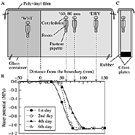Roots of Pisum sativum L. Exhibit Hydrotropism in Response to a Water Potential Gradient in Vermiculite

Roots go round the bend for water
Knowledge of tropisms, the growth of plant organs towards particular stimuli, goes back many years. And yet we are still far from having a complete picture of this set of responses. One of the difficulties is separating the growth patterns that result from two or more tropisms. Mutants that lack particular tropic responses are therefore very useful experimental models. It is exactly this approach that has been taken by Tsuda and co-workers at Tokyo and Sendai (pp. 767-770). They point out that study of root hydrotropism is complicated by root gravitropism. Even for a plant as well-investigated as pea (Pisum sativum), there was no clear evidence for hydrotropism in the soil, although it had been shown in roots exposed to a humidity gradient in air. The authors tackled the problem in an elegantly simple set of experiments. Seeds of an agravitropic pea mutant were germinated in Petri dishes. They were then placed in open-ended glass tubes placed vertically in a glass-sided box containing vermiculite growth medium. The seedlings were positioned so that the roots had to elongate a further 15 mm before exiting from the glass tubes. In the growth medium, the authors set up a gradient of water potential simply by placing a block of wet vermiculite in contact with a block of dry vermiculite. Diffusion of water from wet to dry established the gradient. Roots emerging into completely dry or completely wet vermiculite exhibited no clear directional growth trends. However, most of the roots emerging into the zone of water potential gradient grew strongly towards the wet vermiculite. So pea roots really do exhibit hydrotropism. Furthermore this knowledge is of more than academic interest because, as the authors point out, an understanding of the interactions of hydrotropism and gravitropism in both main and lateral roots will lead to better planning of crop irrigation regimes.
University of Exeter, UK
j.a.bryant{at}exeter.ac.uk